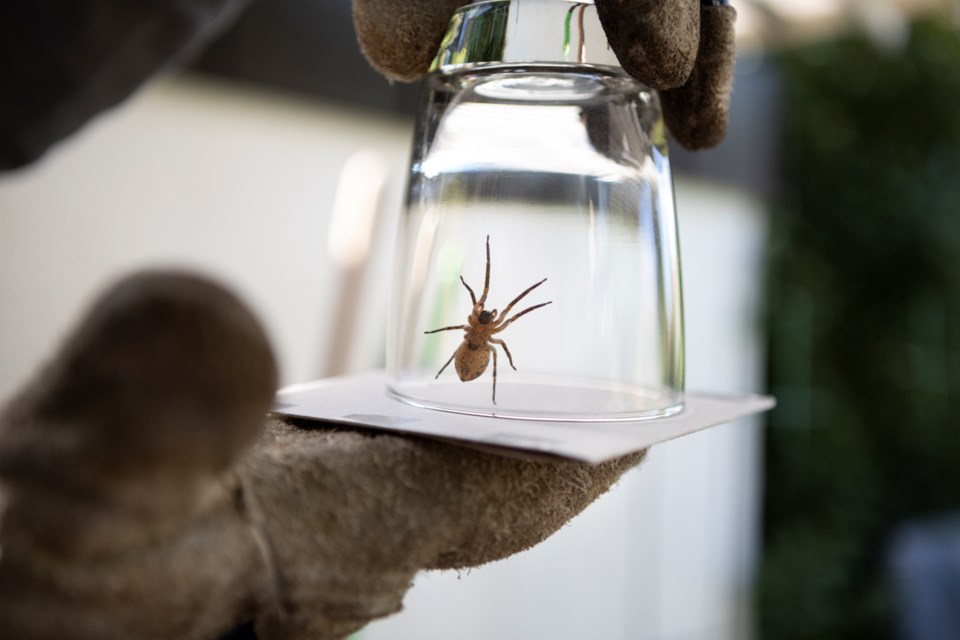On farms, spiders are important predators who control insect populations, including pests that can damage crops.
Understanding their role in agricultural ecosystems reveals how they could be used as a to limit pest populations.
The semi-natural areas that surround farm fields are and other arthropods. These habitats can provide shelter and alternative food sources for spiders when crop fields might be too harsh to live in because of pesticide use or tilling.
Spiders’ diet
To determine whether spiders are effective at biocontrol, it is crucial to know the diet of these spiders and whether they eat crop pests.
The relative size of some insect prey, and the toughness of their exoskeleton, limit spiders’ ability to mechanically chew their food, so they eat by liquefying the remains of their prey.
Spiders onto their prey to break down body tissues. This makes it difficult for researchers to investigate spider diets.
One solution is to analyze the gut contents of spiders using DNA barcoding, a technique that involves sequencing a short, standardized fragment of DNA from a particular gene to identify a species — including any liquefied evidence.
The history of DNA barcoding dates back two decades, when biologist Paul Hebert . Hebert pointed out that animal species could be distinguished by sequencing a specimen’s DNA.
Over the years, this technology has become increasingly sophisticated, with advances in DNA sequencing and bioinformatics making it possible to quickly and accurately identify species from a wide range of samples.
Gut contents
The use of DNA barcoding specifically . By analyzing the DNA found in a spider’s gut, researchers can determine what the spider has eaten and learn about its role in the ecosystem.
The process of begins by capturing spiders in the field. Spiders are then ground up whole into a “DNA soup” using a specific set of steps to extract the DNA from the stomach contents. This grinding step is important because a spider’s stomach extends into many different parts of the body and it’s why total body grinding can .
Researchers can use DNA barcoding to determine if a spider is a generalist — feeding on a wide range of prey species, or a specialist — feeding on a particular species or group of species (like agricultural pests).
With this information, spiders could be deployed as biocontrol agents — a more sustainable, cheaper and environmentally friendly pest management solution.
Generalist predators, including spiders, eat in agricultural landscapes. This includes pest species like and non-pests like .
Researchers found that early season sampling revealed “empty guts” of predators, and an increase of gut contents later in the season. This previous research investigated only three spider species and only during the early and the late cropping season.
Our ongoing research is tackling these gaps.
Sampling spider communities
Our research is conducted in agricultural landscapes with one thing in common: they all have restored habitat adjacent to the crop field. This includes tall-grass prairie and wetland areas.
Different habitat types on farms will undeniably change food web structure on farms, with different prey and predator groups coming in and out throughout the season. These aquatic (wetland) and terrestrial (prairie) habitats may foster spider populations and therefore the biological control function on farms.
We sampled spider communities intensively for four months between May and August, and at different distances from crop fields to study spider movement throughout the crop growing season.
This knowledge is largely important for managing farm systems to help determine the timing of pesticide applications in crop fields.
Spider groups
Our preliminary data has found several spider functional groups — web-spinning, ground spiders, ambush spiders, hunters — on farmlands with restored habitat next to crop fields.
A total of 20 spider families have been consistently found throughout the sampling period, with some spiders more prevalent in certain habitats than others. These 20 spider families on farms is a great number to see considering we have an .
We have been finding a higher abundance of spiders and their insect prey in the semi-natural areas (wetlands, prairies) surrounding the crop fields, and closer to the restored areas.
Our preliminary data also shows that June and August are peak times for spider activity on farms, and they move around a lot more than in May and July.
Providing protection
Gleaning information from spider stomach contents will help understand the role spiders play in the ecosystem. This is particularly important in agriculture to promote environmentally sustainable models for crop protection inspired by natural pest control.
According to a meta-analysis of 58 published studies, , which resulted in improved crop performance.
Relying excessively on chemicals to control crop pests is not a sustainable option; using ecologically based approaches is urgently needed.
DNA barcoding opens up new avenues for studying . And with further advances in DNA sequencing technologies and bioinformatics, this will contribute to agricultural practices that are more sustainable.
![]()
The authors do not work for, consult, own shares in or receive funding from any company or organization that would benefit from this article, and have disclosed no relevant affiliations beyond their academic appointment.




